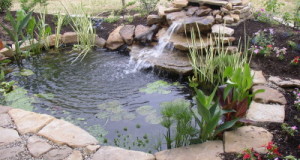I would like to welcome Patty Little back the That Fish Blog, with some more information on planting your plants in your water garden. This article focuses on things that you can do in a natural pond to include water plants that are appropriate for long term success
Welcome Patty
It is probably easy to say that the majority of ornamental backyard water features are manufactured, or lined with manufactured material that forms a contained barrier between introduced plants and the soil beneath and surrounding the pond. Planting a small pre-formed or lined pond is an easier task than deciding on and implementing plants appropriate for a mud bottomed water feature. The possibilities are huge with lined ponds, as any plant can be somewhat easily maintained and controlled by simply lifting out the containers or pots. Though the possibilites are abounding, let’s consider the difficulties presented to those who are trying to waterscape or maintain a large or natural mud bottom pond.
Plants lend aesthetic beauty to any landscape, and when it comes to planting aquatic areas, they are also invaluable for the work they perform in cleaning and processing pollutants from the area. Plants produce oxygen, and remove nitrates and other accumulated compounds in the water to maintain a healthy source for fish and other wildlife. With large areas to populate, many people may not hesitate to introduce certain we’ll known plants to their natural water area without considering the consequences, which may be detrimental to the area.
When considering plant additions to mud bottom ponds two types of plants I would discourage are cattails and hardy water lilies. These plants, even if planted in containers, are highly invasive, and once introduced establish quickly. Once they have a grip on the soil, they will become extremely difficult to remove completely. Lilies can cover the surface of a large pong within a few years, and cattails will spread to cover vast areas of the water’s edge. Though both of these plants are very ornamental and do provide benefits to the pond ecosystem, they are not condusive to a well-manicured waterscape in the long run. Even planted in containers, they seem to find a way to intrude in outside soil.
If you are trying to accomplish a neat waterscape in a mud bottom pond, pay close attention to the hardiness and average max size of the plants you are considering. Some rushes, grasses, creepers, and irises have a very compact and non-invasive growth habit that can be maintained and controlled even if planted in the soil of the water’s edge. Tropical plants planted on the edge may be collected in the fall, and re-planted in the spring if they are out of their hardiness zone, leftover streamers will perish, thus being environmentally controlled. If lilies are definately part of your scheme, consider placing potted lilies on platforms above the mud bottom, and be sure to monitor the tubers each year, pruning or dividing them so they are not allowed to break out of the container. These steps may minimize the possibility of invasion. Tropical lilies are the other safe bet.
Water gardening can be absolutely infatuating, particularly if presented with a large natural canvas. With proper care and consideration, a mud bottom pond can be kept as tidy and beautiful as smaller lined ponds, to please wildlife and people alike for generations.
I hope that you enjoyed Patty’s Article
Untill next blog
Dave
 That Fish Blog – Aquarium Advice and Information
That Fish Blog – Aquarium Advice and Information


Please also be very considerate of avoiding noxious plants, especially in natural ponds. Be sure to double check with either government sponsored web sites or simply do a search for the Latin name of the plant and the words “invasive” or noxious. Just because your local pond store sells a plant does not mean it is safe. In modern society we are all liable these days so it pays to be safe.